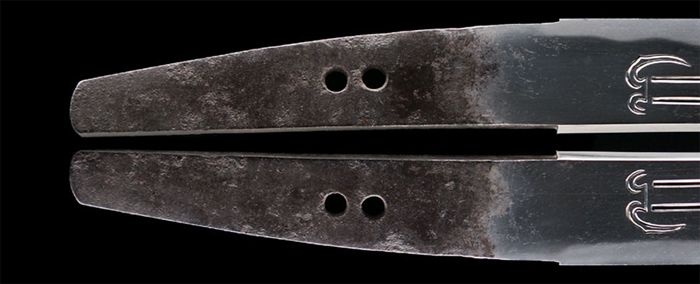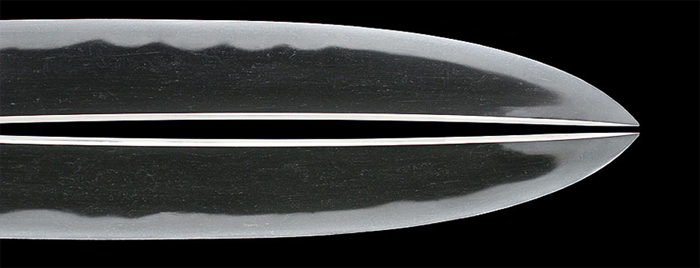SHIMADA (Wakizashi) – Authentic Japanese Sword



Overview
This is an unsigned wakizashi (crafted by an unknown smith).
Shimada is a region in present-day Shizuoka Prefecture. In the Muromachi Era a group of sword makers lived in this region and their katana are collectively referred to as Shimada or Shimada School katana. Unsigned katana are common. Whether or not a sword is signed does not directly affect its value.
Era: End of the Muromachi Era (late 16th century)
Length: 43.9cm
Curve: 0.9cm
Mekugi hole: 2
Accessories: Shirasaya (Plain wood sheath only)
Certification: Hozon Token (a certification of rank issued by the Society for the Preservation of Japanese Art Swords)
Engravings: Front — bonji / so-ken / tsume (Bonji (Sanskrit): kaanman = Cetaka)
Back — bonji / gomabashi / tsume (Bonji (Sanskrit): kaan = Cetaka)
This sword has been sold
* The engravings on both sides each refer to the Buddhist deity Cetaka, but usually a combination of
engravings are used to refer to Cetaka (Fudo Myo-O in Japanese).
engravings are used to refer to Cetaka (Fudo Myo-O in Japanese).
Fudo Myo-o is the best known of the Myō-ō, who are venerated especially by the Shingon sect of Japanese Esoteric Buddhism (Japan’s version of Mahayana Buddhism). Myo-o is the Japanese term for Sanskrit “Vidyaraja,” a group of warlike and wrathful deities known in English as the Mantra Kings, the Wisdom Kings, or the Knowledge Kings.
Fudō Myo-o converts anger into salvation. He has a furious, glaring face, as he seeks to frighten people into accepting the teachings of Dainichi Buddha and he a carries “kurikara” or devil-subduing sword in his right hand (representing wisdom cutting through ignorance) and a rope in his left hand (to catch and bind up demons). Fudō is also worshipped as a deity who can bring monetary fortune. Fudō’s aureole is typically the flames of fire, which according to Buddhist lore, represent the purification of the mind by the burning away of all material desires.
This sword is a typical hira-zukuri wakizashi (short sword) from the late Muromachi Era. Upon entering the Edo Era, the design of wakizashi changed to shinogi-zukuri, making them the same as standard katana.
Since this katana was polished sometime in the Meiji Era, there are a few traces of minor cracking on the surface of the blade, but this in no way affects the value, condition or esthetic merit of the sword.
This katana has a beautiful form and is an excellent example for its time period. The length and width of the katana, the depth of the curvature, and the balance of the kissaki (the part of the blade that tapers to the tip) are all of extremely high quality. The temperline is a type known as notare (wave), which exhibits a gentle arc.
A Samurai Sword to Call Your Own
There are few things in this world that are as inspirational as an antique Japanese sword. With over a thousand years of history, the tradition of swordmaking in Japan is one of the most highly regarded metal crafts in the world. While many aspire to own a genuine Japanese katana, many perceived misconceptions and the difficulty in communicating in English on such an important decision, have made the acquisition process basically out of reach.
Unique Japan is changing all of that. Through our trusted partners in Japan, we are able to source a range of authentic top quality Japanese swords, such as the Shimada wakizashi featured on this page, for much less than what you’d expect to pay at most retail sword shops, given our lower overheads. And we’ve made the process of registration and certification seamless and straightforward. Rest assured, a Japanese sword purchased from Unique Japan is a genuine investment for you, and generations after you, to enjoy.
Questions?
We know this is a big decision, so please feel free to contact us with any questions that you may have. If you are a member of the US Military, and would like to visit one of our special sword shows on a US Military Base in Japan, please refer to our events page for the latest information.


